Sexually Transmitted Infections
The best way to protect yourself and others from STIs is to get regularly tested. Why take the risk?
Background
Sexually transmitted infections (STIs) are a global health concern causing millions of infections each year and billions in healthcare cost.
There are 500,000 new STI infections globally and 1 in 5 people in the US have an STI.
The most common STIs are chlamydia, gonorrhea, trichomoniasis, hepatitis, genital herpes, HIV, HPV, mycoplasma and syphilis.
Untreated STIs can lead to severe health problems in men and women, such as reproductive health problems, pelvic inflammatory disease, ectopic pregnancy, preterm birth, and infertility.
Most people who have chlamydia, gonorrhea or trichomonas do not have symptoms. Rapid diagnosis and screening can improve treatment, reduce complications and reduce the transmission of STIs.
Sexually Transmitted Infection Targets

Chlamydia
Chlamydia is the most frequently reported bacterial STI in US, caused by Chlamydia trachomatis.
CDC estimated about 4 million chlamydia infections in 2018 (US). Most people who have chlamydia do not have symptoms.

Gonorrhea
Gonorrhea is the second most reported bacterial STI in US, caused by Neisseria gonorrhoeae.
CDC estimated about 1,6 million new gonorrhea infections in 2018 (US). Most people who have chlamydia do not have symptoms.

Trichomoniasis
Trichomoniasis is a common curable STI, caused by Trichomonas vaginalis. CDC estimates that there were more than 2 million trichomonas infections in 2018.
Most people who have cannot tell they have it, only 30% is symptomatic. It is a commonly missed infection in woman.

Mycoplasma
Mycoplasma is an STI caused by Mycoplasma genitalium. Can cause discharge, burning and/or pain during urination, vaginal pain, bleeding.
Mycoplasma is an often under recognized STI, it is more common in Europe than US, but in some states the prevalence is higher than Gonorrhea.

Genital Herpes
Herpes is a common STI that can be caused by Herpes simplex virus type 1 and Herpes simplex virus type 2 and is the leading cause of genital ulcer disease. More than 12% of 14-49yr old are infected with genital herpes in US. Genital herpes is a chronic, lifelong viral infection.
There is no cure for genital herpes. Medicine can reduce symptoms and the chance of spreading it to others.
Diagnosing STIs at POC
There are limited tools available at the point of care (POC) to screen for and diagnose STIs fast and accurately.
Molecular PCR is the golden standard for diagnosis but is usually performed in the central lab with up to 5 days turnaround time. Patients often get empirically treated before the lab results come in or patients may be lost to follow up. This can cause mistreatment, discomfort for the patients, insecurities, and further spreading of STIs, without realizing.
Ultra-fast.
Ultra-reliable.


The miDiagnosticsTM HSV-1&2 Swab Test (coming soon) is intended to detect the presence of Herpes simplex virus 1 and 2 in lesion swabs collected from symptomatic patients using an easy-to-use compact PCR system at the POC.
For professional use.
Our HSV 1&2 Swab Test is open for co-development partnerships. Reach out at info@midiagnostics.com to discuss, or contact us here.
Accurate results in less than 20 minutes.
How it works.

Swab Sample
For use with swabs.

PCR Card 2.0
A small volume of the sample is placed on the disposable PCR Card containing the silicon chip.

PCR Reader 2.0
The multiple use, portable reader performs the temperature cycling and optical detection and is connected to a computer.


Computer
The computer with intuitive User Interface and integrated software enables complete sample to answer traceability with easy to interpret results in a data secure manner.
Key Benefits.
Unique silicon chip technology allowing for ultra-fast PCR

Closed reaction chamber limits risk of contamination and cross-infection

Sends reports directly to laboratory/POC information systems, or network printer

“miDiagnostics has the potential to disrupt and transform the industry by making diagnostic information available to clinician and patient alike.”
“Its easy-to-use and cost-efficient test will revolutionize point-of-care testing by directly engaging with patients and enabling speedy intervention.”
“Proud to be leading a top team and together with our numerous partners to make a significant contribution to healthcare in general.”
“As a Non-Executive Director on miDiagnostics’ Board, I have been privileged to witness its continued development. I am very proud to see many years of hard work coming to fruition and providing value, facilitating the return to a normal way of life, with potential to move high quality testing closer to the patient.”
“This technology could aid the management of outbreaks in challenging settings, such as nursing homes and home care environments, allowing healthcare professionals to adjust their management decisions at the point of care. ”




